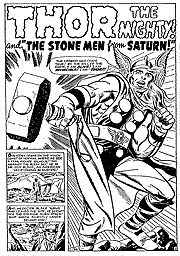|
|
The Evolution Of Thor & The Stone Menby and © Richard Kolkman (with thanks to John Modica and Mark Evanier)From Jack Kirby Collector #14
The "first" Thor faces off against the Sandman and Sandy in Simon & Kirby's "Villain from Valhalla" and follows basic precepts from the Norse legends. Thor has command of both his hammer (Mjolnir) and the elements. The appearance of this red-haired ruffian includes a winged helmet and strapped boots. Thor's invincible hammer smashes open a bank vault and destroys a police car. Thor turns out to be "Fairy Tales" Fenton, a metallurgy professor/robber whose invisible bullet-proof suit and electronically charged hammer are ultimately no match for the Sandman and Sandy. Adventure Comics #75 wasn't the first time Simon and Kirby attempted to fuse mythology into comics; Blue Bolt and Red Raven had mythological ties. Mercury made his one and only appearance in Red Raven #1 and Hurricane (a backup in the first two issues of Captain America) was mentioned to be Thor's son. But it isn't until more than 15 years later that Kirby (sans Simon) revisits the Thor concept in DC's Tales of the Unexpected #16 (August 1957, reprinted in DC Special #4, Sept. 1969).
Origins Of The Stone MenThor wasn't the only concept that got reused in JIM #83. The Stone Men from Saturn evolved as well, appearing in no less than four stories before their run-in with the god of thunder.
According to Joe Simon's book The Comic Book Makers, DC editor Jack Schiff put together the deal that landed Kirby his syndicated comic strip Sky Masters in 1958. For his efforts, Schiff expected a cut of the proceeds, and when Jack (for whatever reason) refused to pay, Schiff sued him. The dispute with Schiff caused him to leave DC, and soon after Kirby's return to Marvel, "I Was Trapped by the Things on Easter Island" appeared in Tales to Astonish #5 (Sept. 1959, reprinted in Where Monsters Dwell #24). Alien stone giants from Lithodia Rex pursue a hapless wrecked pilot who has overheard their conquest aspirations. He escapes the island, and the alien things actually traverse the ocean to peek into the man's bedroom. Satisfied that they are safe from discovery, they wade back to Easter Island to their buried positions to await their summons. It's only conjecture, but did Jack reuse the DC Stone Men concept at Marvel to get Schiff's goat? Two years later, "Here Comes Thorr the Unbelievable" grafts the Thor(r) name onto the Stone Men concept in Marvel's Tales to Astonish #16 (February 1961, reprinted in Where Creatures Roam #3 as "Thorg the Unbelievable"). This time, an archaeologist discovers South Pacific Stone Men (buried up to their necks) who are alien mechanical monstrosities awaiting the signal to dominate the world. This spelling of Thorr is also reflected in the last panel of the JIM #83 debut on the side of Thor's hammer.
By the spring of 1962, The FF, Hulk, and other Marvel superheroes were rapidly eclipsing the existing comic books in Marvel's lineup. In his book Origin of Marvel Comics, Stan Lee described how he was suddenly inspired to adapt Norse mythology into Marvel's burgeoning superhero roster. Lee named the new character "Thor" because, as Stan explained, "I liked the sound of his name. It was short, simple, easy to remember, and if you lisped nobody would know." With great inspiration comes great responsibility.  Thor © & ™ Marvel Characters, Inc. Jack must have been receptive to Stan's idea, because he penciled Thor until issue #179, after which he returned to DC. Upon Kirby's return to Marvel in 1975, one of his many covers was for Thor #255. The Stone Men's gravity ray has Thor at a disadvantage in this, their final Kirby Konfrontation. As a Stone Men postscript, DC's Super Powers #3 (November 1985) features Jack's cover and story pencils on "Time Upon Time Upon Time." The buried (up to their neck, remember?) Stone Men of Easter Island terrorize Dr. Fate, Wonder Woman and Green Lantern. They are, of course, the advance guard for an ambitious alien planet. After an aimless battle, Dr. Fate sends the Stone Men to their final destiny. Verily, thus concludes Jack Kirby's fascination with the mixture of Easter Island's iconography and the Norse legend of Thor, the god of thunder.  Sign up here to receive periodic updates about what's going on in the world of TwoMorrows Publishing. |